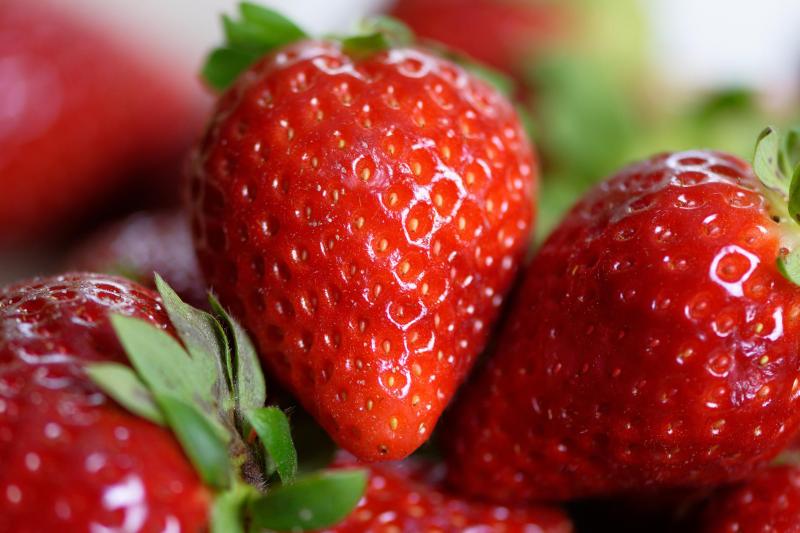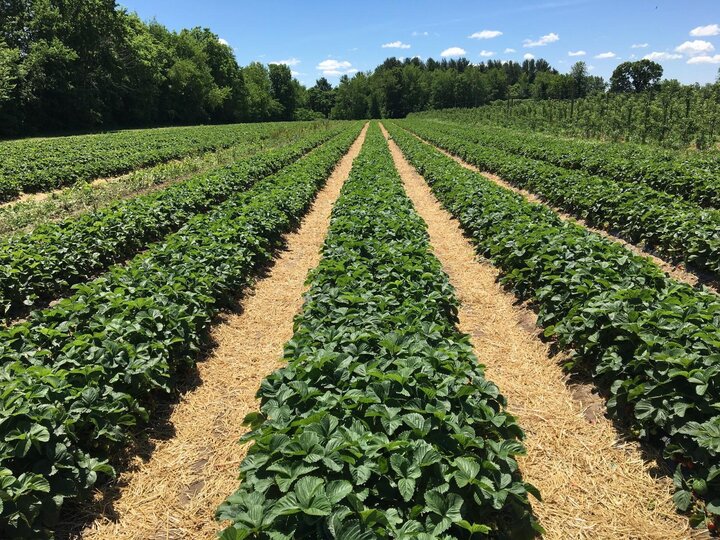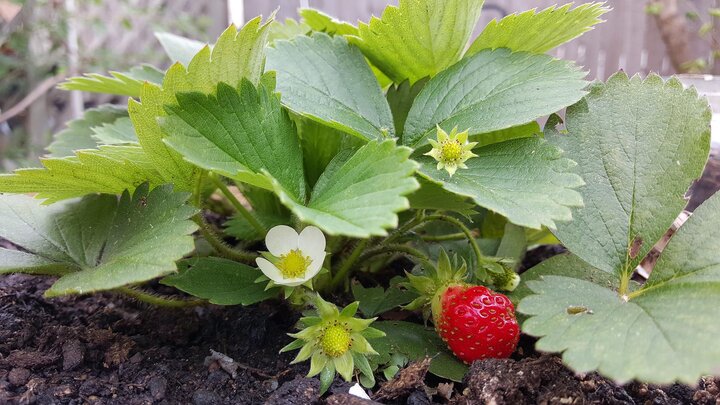Sarah Browning, Nebraska Extension Educator

Strawberry plantings can produce for several years, but require yearly renovation to their most productive. Image by Pixabay
Strawberry plantings can produce for several years, but yields decrease with each year of harvest. Diseases, weeds and weak plants limit the life span of a single planting, so do not expect a bed to maintain its quality for more than three fruiting seasons. By following the recommended renovation or renewal procedures, you can maximize the life and productivity of your planting.

Most June bearing strawberries are planted using the matted row system. Plants are originally planted 18-24 inches apart, then are allowed to grow together forming thick mats of foliage. To renovate a planting in a matted row system, narrow the rows immediately after harvest to a width of 10-15 inches, by running a tiller along the edges of the rows, removing all the extra plants.
Sometimes strawberries are allowed to grow together in one thick, matted bed with no walkways. In this case, run the tiller through the strawberry planting creating 24 inch wide walkways through the bed and leaving 10-15 inch wide rows of strawberries.
After tilling, mow off the old leaves to one inch above the crown. Remove all the leaf debris and plants destroyed by tilling. This will reduce disease problems on newly developing foliage and allow you to see the plants. Thin out the remaining plants leaving three plants per square foot or thin plants to a spacing of 7-11 inches apart by removing old mother plants and weak new runner plants.
Apply 2 ½-3 pounds of a complete fertilizer such as 10-10-10 or 12-12-12 per 100 feet of row.
If weather and time permit, thin out weak plants again in late September. By mid-October there should be only five to seven plants per square foot to get top yields the following spring. Thinning out the plants only after harvest usually is not sufficient to maintain the plant density required to optimize yields and quality.
Ever-bearing Strawberries
Renovation as described for June bearing strawberries, is not practiced with day neutral or everbearing strawberries. To maintain productive everbearing strawberries, when using the hill planting system, set new plants into new hills each year, and remove plantings more than 3 years old. Runners are normally removed as they appear, especially if the hill system is used.

When preparing strawberry plants for planting, never allow them to dry out. Cover the roots with moist peat moss or cloth, and keep the plants shaded at all times. Before planting, remove all but two or three well-developed leaves per plant. Clip off any flower clusters that are visible to save the labor of removing them later in the field.
Spread out the roots when planting and place the plant at a depth so that only the base of the crown is covered by soil. If the crown is too high, the roots will be exposed and quickly will dry out. If the crown is too deep, it easily can be covered with soil and smothered.
Follow-up Care
Irrigation and mulch are important for plant recovery following renovation, and good flower bud development in later summer.
Strawberries must be irrigated to produce quality fruit with high yields. Plants generally require 1.5-2 inches of water or more per week, both rain and irrigation, depending on soil type, climatic conditions such as temperatures and wind, and the plant's stage of development.
Crucial water-use times for strawberries occur following renovation, and in late summer when flower buds are forming. Because the strawberry fruit is 90 percent water, any moisture stress during fruit development will reduce yield. If signs of water deficits, such as wilting, occur, apply water as soon as possible. Apply enough water to wet the soil to a depth of six to eight inches, the zone in which most of the plant's roots occur.
Most home strawberry plantings are mulched. Any organic material, free of weed seeds, makes good mulch, like hay, straw, and pine needles. In spring, after the danger of frost is past, rake half the mulch off the plants and into the area between the rows. Mulch left around and under the plants will help keep the berries clean, conserve moisture, and inhibit weed growth.
Black plastic is frequently used as mulch for strawberries. It is effective in inhibiting weed growth and preventing the evaporation of moisture from the soil surface. However, it does eliminate the ability of runners to put down roots.
Images from Pixabay.com
- Wide row strawberry plantings are a good system to use in the home garden, just as they are for commercial growers.
- Next year's flower buds begin forming in late summer, so maintaining good moisture in the late summer and fall garden is crucial for your next harvest.
Search Our Archive
Associated Video
Growing Strawberries
Nebraska Extension Educator Kathleen Cue talks about selecting, installing and caring for strawberries.